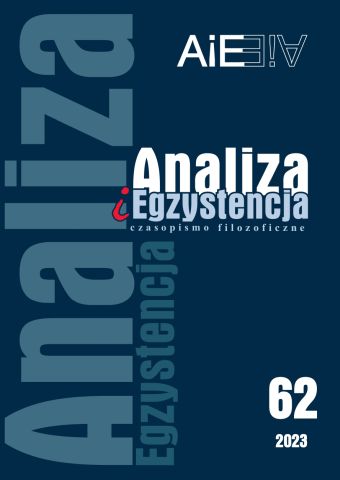
ISSN: 1734-9923
eISSN: 2300-7621
OAI
DOI: 10.18276/aie.2023.62-01





Lista wydań /
62 (2023)
Real Deletion, Time, and Possibility
(Rzeczywiste usunięcie, czas i możliwość.)
| Autorzy: |
Randall
Auxier

Southern Illinois University, Carbondale |
| Słowa kluczowe: | czas proces sztuczna inteligencja czasowość potencja Whitehead Bergson |
| Data publikacji całości: | 2023 |
| Liczba stron: | 37 (5-41) |
Abstrakt
Czy coś naprawdę „odchodzi” całkowicie? Niniejszy artykuł jest poszukiwaniem „rzeczywistego usunięcia” i metafizyki, która musi temu towarzyszyć. Dlaczego to jest ważne? W badaniach nad sztuczną inteligencją naukowcy zaproponowali ruchomy punkt docelowy do momentu osiągnięcia sztucznej inteligencji. Zaczęło się od testu Turinga i ewoluowało przez dużą ilość argumentacji (np. Dreyfussa, dotyczącą tego, czego nie potrafią komputery, przez „osobliwość” Kurzweila oraz wiele innych kryteriów i tysiące dyskusji na temat tego, czym jest inteligencja i co oznaczałoby ją symulować lub, jak wolę, naśladować). Cała ta dyskusja wciąż polega na rozważaniu analogii do ludzkiej inteligencji, a nie na zbliżaniu się do samej rzeczy, ale dobre analogie muszą dotyczyć czegoś znacznie więcej
niż funkcji analogicznej: muszą zbliżać się do prawdziwej nieodróżnialności. Moje wywody będą zatem dotyczyły głównie dziedziny metafizyki i ontologii, tak jak rozumiem słowo „rzeczywisty” w wyrażeniu „rzeczywiste usunięcie”. Nie sądzę, aby współcześni badacze właściwie rozumieli problem czasu i jego wpływ na kryterium lub. kryteria sztucznej inteligencji. Stąd j w tych ramach oferuję „rzeczywiste usunięcie” w znaczeniu, które należy właśnie opisać. Argument AI ma implikacje dla całej metafizyki, ponieważ odnosi się do fundamentalnego charakteru czasu.
Pobierz plik
Plik artykułu
Bibliografia
| 1. | Anderson, M. (2019). Hyperthematics: The logic of value. SUNY Press. |
| 2. | Auxier, R. (1999). Influence as confluence: Bergson and Whitehead. Process Studies, 28(3–4), 301–338. https://doi.org/10.2307/44789317. |
| 3. | Auxier, R. (2013). Time, will, and purpose: Living ideas from the philosophy of Josiah Royce. Open Court. |
| 4. | Auxier, R. (2014a). Complex negation, necessity, and logical magic. In K. A. Parker, & J. M. Bell (Eds.), The relevance of Royce. Fordham University Press. |
| 5. | Auxier, R. (2014b). In vino veritas. Southwest Philosophy Review, 30(1), 39–66. https://doi.org/10.5840/swphilreview20143015 |
| 6. | Auxier, R. (2014c). Image and act: Bergson’s ontology and aesthetics. Sztuka i Filozofia, 45, 64–81. |
| 7. | Auxier, R. (2015). The sherpa and the sage: Neville on the determinate and the possible. American Journal of Theology & Philosophy, 36(1), 37–50. https://doi.org/10.5406/amerjtheophil.36.1.0037. |
| 8. | Auxier, R. (2016). Evolutionary time, and the creationof the space of life. In S. Wuppuluri, & G. Ghirardi (Eds.), Space, time, and the limits of human understanding (pp. 381–400). Springer Verlag. |
| 9. | Auxier, R., & Herstein, G. (2017). The quantum of explanation. Routledge. |
| 10. | Auxier, R. (2021). Logic: From images to digits. Rylan. |
| 11. | Auxier, R. (2022, June 21–24). The virtues in the virtual: Langer’s projections and the digital world [Conference presentation]. Feeling, Form, Mind: A Conference on the Thought of Susanne K. Langer, Max Planck Institute for Empirical Aesthetics, Frankfurt am Main, Germany. https://www.aesthetics.mpg.de/fileadmin/user_upload/300-Newsroom/EVENTS/220622-Conference-Susanne-K-Langer/Grueny-Susanne-Konferenz-Programm-Abstracts-07a-ONLINE.pdf. |
| 12. | Auxier, R. (2022, July 19–21) The virtues in the virtual: Langer’s projections and the digital world [Keynote speech]. International Conference on Robot Ethics and Standards, Korean Society for AI Ethics, the Korean Association for Ethics, and the CLAWAR Association, Seoul, South Korea. |
| 13. | Bergson, H. (1983). Creative evolution. University Press of America. |
| 14. | Bergson, H. (1988). Matter and memory. Zone Books. |
| 15. | Brightman, E. S. (1933). Moral laws. Abingdon Press. |
| 16. | Buchler, J. (1989). Metaphysics of natural complexes. SUNY Press. |
| 17. | Canales, J. (2015). The physicist and the philosopher. Harvard University Press. |
| 18. | Cassirer, E. (1923). Einstein’s theory of relativity (W. C. Swabey, & M.C. Swabey, Trans.). Open Court. |
| 19. | Eastman, T. E. (2020). Untying the Gordian knot: Process, reality, and context. Lexington Books. |
| 20. | Haynes, J. (2005). Comparative politics in a globalizing world. Polity. |
| 21. | Jones, J. A. (1999). Intensity: An essay in Whiteheadian ontology. Vanderbilt University Press. |
| 22. | Kant, I. (1987). Critique of judgment (W. S. Pluhar, Trans.). Hackett. |
| 23. | Kirkpatrick, A. T. (2020). Whitehead and Merleau-Ponty: Toward a process phenomenology [Master’s dissertation, Deakin University]. |
| 24. | Kokot, J. D. (2022). The phenomenology of temporality and the technologies of art [Doctoral dissertation, Boston University]. |
| 25. | Langer, S. (1967). An introduction to symbolic logic. Dover. |
| 26. | Mead, G. H. (1998). The present as the locus of reality. In D. Browning, & W. T. Myers (Eds.), Philosophers of process (pp. 349–370). Fordham University Press. |
| 27. | Merleau-Ponty, M. (1962). The phenomenology of perception. Routledge & Kegan Paul. |
| 28. | Murray, L. M. (2021). The crisis of dislocated beings [Prospectus Introduction]. Southern Illinois University. |
| 29. | Ohanian, H. (2009). Einstein’s mistakes. W. W. Norton and Co.Prigogine, I, & Stengers, I. (1984). Order out of chaos: Man’s new dialogue with nature. Bantam Books. |
| 30. | Sartre, J. P. (1948). The psychology of imagination. Philosophical Library. The Institute of Art and Ideas (2018). Why classical ideas of gravity are wrong: Chiara Marletto [Video]. YouTube. https://www.youtube.com/watch?v=dGe6N_FNB4g&t=2s. |
| 31. | Taleb, N. N. (2010). The black swan: The impact of the highly improbable. Random House. |
| 32. | Whitehead, A. N. (1922). The principle of relativity. Cambridge University Press. |
| 33. | Woit, P. (2007). Not even wrong. Basic Books. |
| 34. | Tengelyi, L. (2004). The wild region in life history. Northwestern University Press. |